Gross domestic product decreased in January to March, Finland’s national economy suffered from weak demand
In January to March, the seasonally adjusted volume of Finland’s gross domestic product decreased by 0.1 per cent from the previous quarter. GDP adjusted for working days went down by 1.0 per cent compared to the first quarter of 2020. Examined at current prices, gross domestic product adjusted for working days was 0.1 per cent higher than one year ago.
Figure 1. Volume change of GDP from the previous quarter, seasonally adjusted, per cent
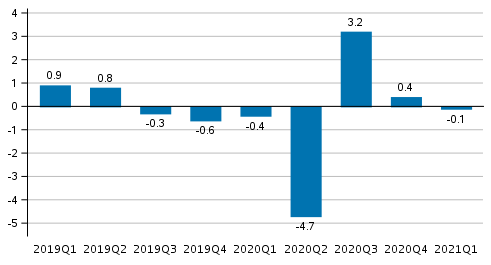
According to preliminary data compiled by Eurostat, gross domestic product in the EU area decreased by 0.4 per cent in the first quarter compared to the previous quarter.
Output
The volume of total value added generated by all industries grew by 0.2 per cent from the previous quarter but decreased by 0.8 per cent from twelve months back.
Figure 2. Changes in the volume of value added generated by industries in the first quarter of 2021 compared to one year ago, working day adjusted, per cent
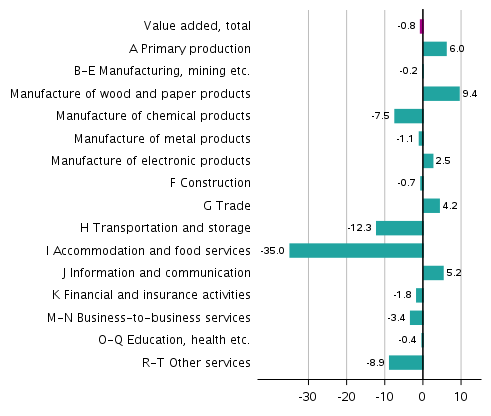
Figure 3. Changes in the volume of value added generated by industries in the first quarter of 2021 compared to the previous quarter, seasonally adjusted, per cent
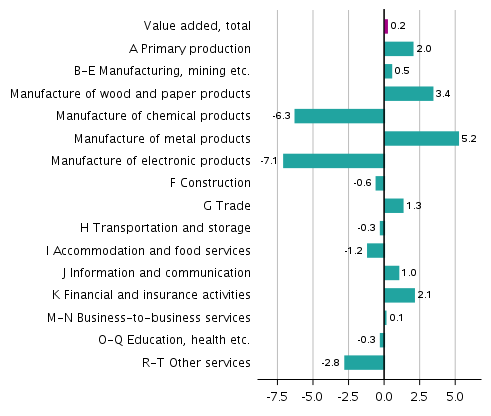
In primary production, that is, agriculture, forestry and fishing, the volume of value added grew in January to March compared with both the previous quarter and the year before.
Output in manufacturing industries (incl. mining and quarrying, energy, water supply and waste management) grew in January to March from the previous quarter but was slightly lower than one year ago. The forest and metal industries grew from the previous quarter, but the chemical, electrical and electronics industries contracted. The decline in construction continued through January to March.
In service industries value added grew slightly in the first quarter of 2021 from the previous quarter but remained lower than one year ago. The coronavirus crisis started during the first quarter of 2020 and has had particularly strong impact on the industries of transport, accommodation and food service activities. In many other service industries, too, value added remained lower than one year ago. The trade industry grew, while in January to March especially motor vehicle trade increased clearly, and information and communication activities have also fared well throughout the coronavirus crisis.
Imports, exports, consumption and investments
Total demand decreased in January to March by 0.8 per cent from the previous quarter. Investments grew from the previous quarter after a long time but exports in particular diminished briskly.
Figure 4. Changes in the volume of main supply and demand items in the first quarter of 2021 compared to one year ago, working day adjusted, per cent
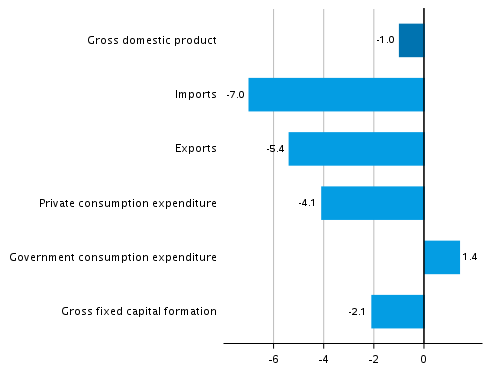
Figure 5. Changes in the volume of main supply and demand items in the first quarter of 2021 compared to the previous quarter, seasonally adjusted, per cent
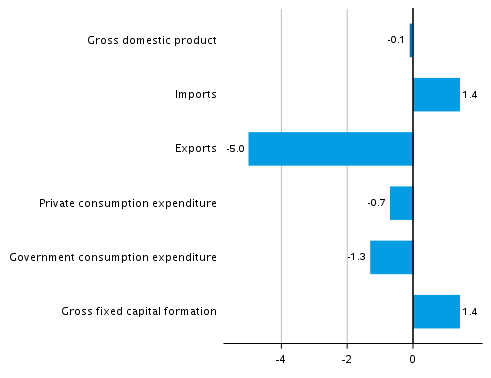
In January to March, the volume of exports of both goods and services decreased from the previous quarter. By contrast, the volume of imports increased. International trade in services has suffered more from the coronavirus than exports and imports of goods, because in January to March exports and imports of services were still nearly 20 per cent lower than one year ago. The prices of international trade in goods rose clearly in March, so when examined at current prices, the value of goods exports decreased from the previous quarter less (-3.6%) than when examined as volume (-6.3%).
Private consumption decreased in January to March compared with the previous quarter. Compared with the first quarter of 2020, when the corona crisis was only starting, consumption of services has remained nearly ten per cent lower. Government consumption expenditure decreased from the previous quarter but was on a higher level than twelve months back.
Gross fixed capital formation, or investments, grew from the previous quarter. Public investments decreased but private investments grew. Investments in buildings, machinery, equipment and transport equipment grew from the previous quarter but remained lower than one year ago. Investments in research and development and software diminished.
Employment, wages and salaries and national income
In January to March the number of employed persons went down by 0.7 per cent and that of hours worked by 2.2 per cent from one year back. From the previous quarter, the number of hours worked diminished by 0.3 per cent.
In the January to March period, the nominal wages and salaries bill of the national economy grew by 0.3 per cent from the previous quarter and by 0.1 per cent year-on-year. Social contributions paid by employers grew by 6.7 per cent from one year back.
The operating surplus (net), which in business bookkeeping corresponds roughly with operating profit, decreased in the first quarter by 3.0 per cent from twelve months back. Gross national income calculated at current prices was 1.2 per cent higher than one year previously.
The available data
These preliminary quarterly data are based on the source information on economic development that had become available by 21 May 2021. The annual level data for 1990 to 2019 correspond with the National Accounts data released on 26 February 2021, except for those on the rest of the world sector (imports, exports, primary income from/to the rest of the world), which may have become revised. More detailed data for 2020 will be published on 14 July 2021, when the quarterly accounts database tables will also be updated.
The responsibility for collecting quarterly data on the finances of municipalities and joint municipal authorities was transferred from Statistics Finland to the State Treasury in early 2021: http://www.stat.fi/uutinen/kuntatalouden-neljannesvuositiedot-julkaistu-ensimmaista-kertaa-tutkikuntiafi-palvelussa The aim of the new data collection has been advanced automation. In addition, the collected data content is more comprehensive than before. The changes may initially have an effect on the quality and comparability of data concerning general government from the perspective of statistics compilation.
Data concerning the second quarter of 2021 will be released on 31 August 2021. A flash estimate on GDP development for April to June will be released in connection with the June data of the Trend Indicator of Output on 17 August 2021.
Due to the benchmarking and seasonal adjustment methods, quarterly data may become slightly revised in connection with each release. However, the largest revisions take place during the two to three years following the release on a quarter, because final annual accounts data are published at a lag of around two years from the end of the statistical reference year. Seasonally adjusted and trend time series always become revised against new observations irrespective of whether the original time series becomes revised or not.
The quality description is available on Statistics Finland's website: http://www.tilastokeskus.fi/til/ntp/laa.html .
Methodological description of Quarterly National Accounts.Source: National Accounts 2021, 1st quarter. Statistics Finland
Inquiries: Samu Hakala 029 551 3756, Antti Kosunen 029 551 3613, kansantalous.suhdanteet@stat.fi
Head of Department in charge: Katri Kaaja
Updated 28.5.2021
Official Statistics of Finland (OSF):
Quarterly national accounts [e-publication].
ISSN=1797-9765. 1st quarter 2021,
Gross domestic product decreased in January to March, Finland’s national economy suffered from weak demand
. Helsinki: Statistics Finland [referred: 13.12.2025].
Access method: http://stat.fi/til/ntp/2021/01/ntp_2021_01_2021-05-28_kat_001_en.html

